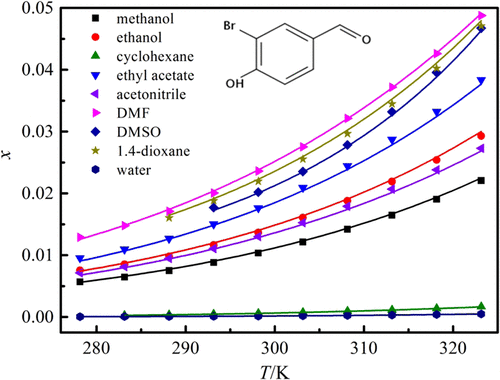当前位置:
X-MOL 学术
›
J. Chem. Eng. Data
›
论文详情
Our official English website, www.x-mol.net, welcomes your feedback! (Note: you will need to create a separate account there.)
Solubility of 3-Bromo-4-Hydroxybenzaldehyde in 16 Monosolvents at Temperatures from 278.15 to 323.15 K
Journal of Chemical & Engineering Data ( IF 2.6 ) Pub Date : 2019-12-31 , DOI: 10.1021/acs.jced.9b01004 Zhehua Jia 1 , Hao Yin 1 , Youhua Zhao 1 , Hongkun Zhao 1
Journal of Chemical & Engineering Data ( IF 2.6 ) Pub Date : 2019-12-31 , DOI: 10.1021/acs.jced.9b01004 Zhehua Jia 1 , Hao Yin 1 , Youhua Zhao 1 , Hongkun Zhao 1
Affiliation

|
The solubility of 3-bromo-4-hydroxybenzaldehyde in 16 monosolvents of n-pentanol, methanol, isobutanol, ethanol, ethylene glycol (EG), n-propanol, acetonitrile, isopropanol, N,N-dimethylformamide (DMF), n-butanol, n-octanol, cyclohexane, water, ethyl acetate, dimethylsulfoxide (DMSO), and 1,4-dioxane was attained through experiment via the saturation shake-flask method covering from 278.15 K to 323.15 K under local ambient pressure p = 101.2 kPa. The solubility magnitude in mole fraction of 3-bromo-4-hydroxybenzaldehyde in the selected solvents raised as the studied temperature raised and had the subsequent order in various monosolvents: (n-octanol, DMF) > 1,4-dioxane > (DMSO, n-pentanol) > n-butanol > isobutanol > ethyl acetate > n-propanol > isopropanol > ethanol > acetonitrile > EG > methanol > cyclohexane > water. The interactions of solvent–solute and solvent–solvent molecules were inspected by using a method of linear solvation energy relationships. The NRTL model, λh equation, modified Apelblat equation, and Wilson model were employed herein to mathematically correlate the solubility data. The results specified that the gained maximum relative average deviation (RAD) and root-mean-square deviation (RMSD) values through these models/equations were, respectively, 2.86 × 10–2 and 942.9 × 10–6. The RAD values were lower obtained through the modified Apelblat equation than the other equations/models for a given solvent. As well, the mixing properties of dissolution, activity coefficient at infinitesimal concentration, and reduced excess enthalpy were calculated based on the Wilson equation.
中文翻译:

在278.15至323.15 K的温度下3-溴-4-羟基苯甲醛在16种单溶剂中的溶解度
3-溴-4-羟基苯甲醛在16种正戊醇,甲醇,异丁醇,乙醇,乙二醇(EG),正丙醇,乙腈,异丙醇,N,N-二甲基甲酰胺(DMF)和正丁醇的单溶剂中的溶解度,ñ辛醇,环己烷,水,乙酸乙酯,二甲亚砜(DMSO),1,4-二恶烷是通过经由来自278.15ķ覆盖饱和摇瓶法实验获得到在局部环境压力323.15ķ p = 101.2千帕。随着研究温度的升高,在所选溶剂中3-溴-4-羟基苯甲醛的摩尔分数溶解度大小也随之升高,并且在各种单溶剂中具有以下顺序:(n-辛醇,DMF)> 1,4-二恶烷>(DMSO,正戊醇)>正丁醇>异丁醇>乙酸乙酯>正丙醇>异丙醇>乙醇>乙腈> EG>甲醇>环己烷>水。使用线性溶剂化能量关系的方法检查了溶剂-溶质和溶剂-溶剂分子之间的相互作用。的NRTL模型,λ ħ方程,修正Apelblat方程,和Wilson模型,本文所采用的溶解度数据数学相关。结果表明,通过这些模型/方程式获得的最大相对平均偏差(RAD)和均方根偏差(RMSD)值分别为2.86×10 –2和942.9×10 –6。对于给定的溶剂,通过修正的Apelblat方程获得的RAD值低于其他方程/模型。同样,基于威尔逊方程,计算了溶出度,最小浓度下的活度系数和降低的过量焓的混合性质。
更新日期:2019-12-31
中文翻译:

在278.15至323.15 K的温度下3-溴-4-羟基苯甲醛在16种单溶剂中的溶解度
3-溴-4-羟基苯甲醛在16种正戊醇,甲醇,异丁醇,乙醇,乙二醇(EG),正丙醇,乙腈,异丙醇,N,N-二甲基甲酰胺(DMF)和正丁醇的单溶剂中的溶解度,ñ辛醇,环己烷,水,乙酸乙酯,二甲亚砜(DMSO),1,4-二恶烷是通过经由来自278.15ķ覆盖饱和摇瓶法实验获得到在局部环境压力323.15ķ p = 101.2千帕。随着研究温度的升高,在所选溶剂中3-溴-4-羟基苯甲醛的摩尔分数溶解度大小也随之升高,并且在各种单溶剂中具有以下顺序:(n-辛醇,DMF)> 1,4-二恶烷>(DMSO,正戊醇)>正丁醇>异丁醇>乙酸乙酯>正丙醇>异丙醇>乙醇>乙腈> EG>甲醇>环己烷>水。使用线性溶剂化能量关系的方法检查了溶剂-溶质和溶剂-溶剂分子之间的相互作用。的NRTL模型,λ ħ方程,修正Apelblat方程,和Wilson模型,本文所采用的溶解度数据数学相关。结果表明,通过这些模型/方程式获得的最大相对平均偏差(RAD)和均方根偏差(RMSD)值分别为2.86×10 –2和942.9×10 –6。对于给定的溶剂,通过修正的Apelblat方程获得的RAD值低于其他方程/模型。同样,基于威尔逊方程,计算了溶出度,最小浓度下的活度系数和降低的过量焓的混合性质。


























 京公网安备 11010802027423号
京公网安备 11010802027423号